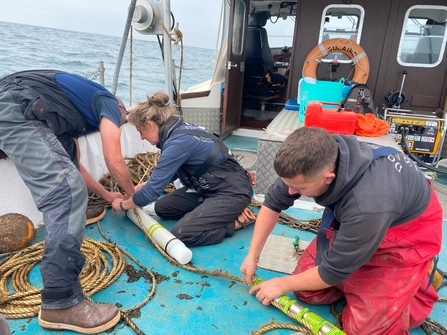Cardigan Bay, nestled along the rugged coast of Wales, is not only a haven for breathtaking landscapes but also a critical habitat for marine life. In the autumn, our WTSWW research team from the Cardigan Bay Marine Wildlife Centre embarked on a necessary venture to deploy acoustic equipment beneath the waves, with the aim of continuing to gather vital information to help unravel some of the mysteries of the sea’s acoustic symphony.
October 2023, between the autumnal storms, our team had an opportunity to service the static acoustic recorders that we have deployed in Cardigan Bay. Servicing our equipment involves meticulous attention to detail – batteries need to be charged, checked, and double-checked, SD cards need to be formatted and installed, and equipment set up so it will continue to record over the winter months!
The boat team from Dolphin Survey Boat Trips, assisting with the servicing need to be readied and on standby so as not to miss the weather window. What seems like a simple mission involves many different strands coming together to ensure the task runs smoothly. We now have this process down to a fine art, having successfully deployed and recovered a number of pieces of equipment over the last few years. Good communication, collaboration, clear roles, understanding, and prioritizing are key to success, especially when working in the marine environment!
In the crisp autumn air, we set off to deploy our static hydrophones at strategic locations in Cardigan Bay. As winter storms swept across the bay, our acoustic equipment faced the relentless power of the elements. Harsh winds, turbulent waves, and falling temperatures posed challenges to the durability of the submerged devices. However, we remain optimistic, knowing that the potential insights gained will be invaluable in understanding dolphin movements in Cardigan Bay.
Now, as spring dawns on Cardigan Bay, the time has come to retrieve the acoustic equipment. A carefully planned recovery mission is underway. We'll soon be braving the elements to recover our equipment in order to extract the data that has been silently accumulating over the winter months.
This winter has been a stormy one; the wind and rain have been relentless so much of it has been spent ashore. We’ve been busy continuing to process our boat survey data and our photo-identification images. However, we have taken every occasion presented to seize the opportunity to continue our boat surveys, looking out for bottlenose dolphins. Cardigan Bay is renowned for its semi-resident population of bottlenose dolphins, although the bottlenose dolphin movements over the winter months are somewhat of an enigma. We have been conducting surveys over the winter for a few years now, each year presenting its own challenges, mainly in terms of weather conditions, but dolphin sightings have also varied each year!
Excitingly, during surveys in the past two years, we have observed very large groups of bottlenose dolphins; expectations for this year were high, but unfortunately, our winter boat surveys so far have been quiet on the dolphin front. We look forward to seeing what sightings spring brings us.
The deployment of acoustic equipment and boat surveys in Cardigan Bay over the winter months represents a unique exploration into the Cardigan Bay marine life. As we look forward to recovering our equipment and continuing to conduct our bottlenose dolphin surveys, we hope to piece together a more comprehensive understanding of the bay's underwater ecosystem.
This winter tale of science and discovery contributes not only to our knowledge of marine life in Cardigan Bay but also underscores the importance of studying these environments throughout the changing seasons.

